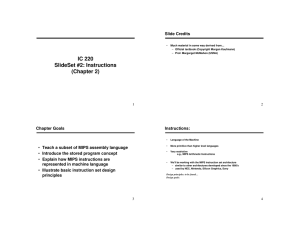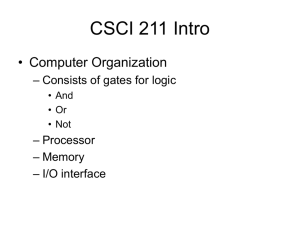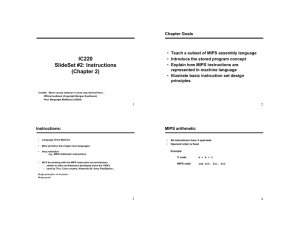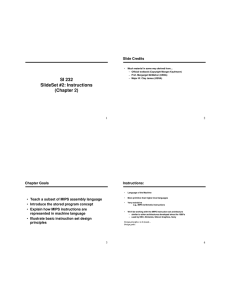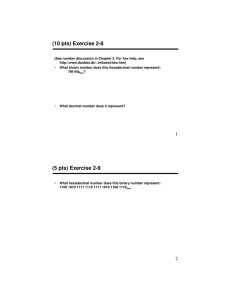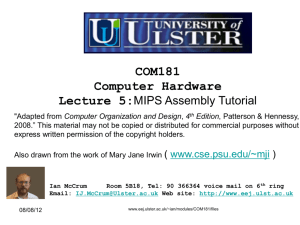IC220 SlideSet #2: Instructions
advertisement
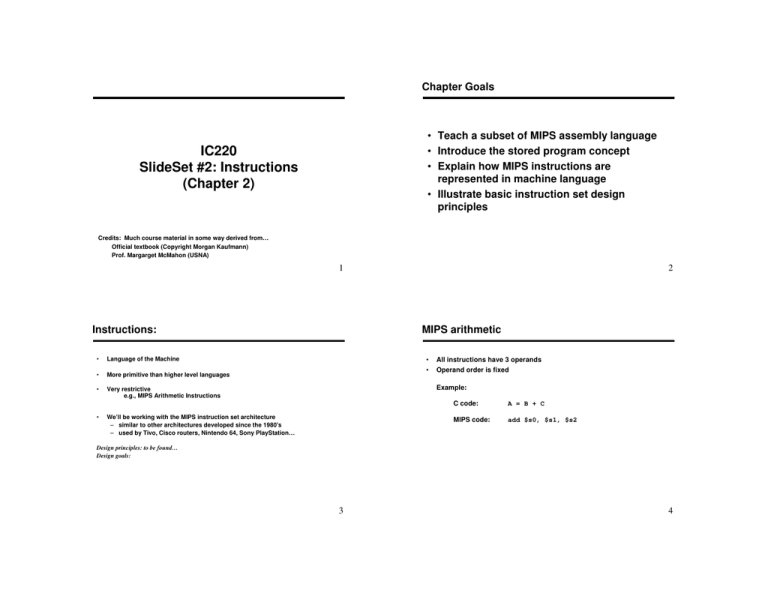
Chapter Goals • Teach a subset of MIPS assembly language • Introduce the stored program concept • Explain how MIPS instructions are represented in machine language • Illustrate basic instruction set design principles IC220 SlideSet #2: Instructions (Chapter 2) Credits: Much course material in some way derived from… Official textbook (Copyright Morgan Kaufmann) Prof. Margarget McMahon (USNA) 1 Instructions: • Language of the Machine • More primitive than higher level languages • Very restrictive e.g., MIPS Arithmetic Instructions • 2 MIPS arithmetic • • All instructions have 3 operands Operand order is fixed Example: We’ll be working with the MIPS instruction set architecture – similar to other architectures developed since the 1980's – used by Tivo, Cisco routers, Nintendo 64, Sony PlayStation… C code: A = B + C MIPS code: add $s0, $s1, $s2 Design principles: to be found… Design goals: 3 4 MIPS arithmetic Registers vs. Memory • Design Principle #1: simplicity favors regularity. • Of course this complicates some things... C code: A = B + C + D; E = F - A; MIPS code: add $t0, $s1, $s2 add $s0, $t0, $s3 sub $s4, $s5, $s0 Why? • Design Principle #2: smaller is faster. Why? • Therefore, arithmetic instruction operands must be “registers” – And only 32 registers provided Control Input Memory Datapath Processor • • Output I/O Compiler associates variables with registers What about programs with lots of variables? 5 Memory Organization • • • 6 Memory Organization Viewed as a large, single-dimension array, with an address. A memory address is an index into the array "Byte addressing" means that the index points to a byte of memory. • • Bytes are nice, but most data items use larger "words" For MIPS, a word is 32 bits or 4 bytes. 0 0 1 2 3 4 5 6 8 bits of data 8 bits of data 8 bits of data • • • 8 bits of data 8 bits of data 8 bits of data 32 bits of data Registers hold 32 bits of data 4 32 bits of data 8 32 bits of data 12 32 bits of data ... 232 bytes with byte addresses from 0 to 232-1 230 words with byte addresses 0, 4, 8, ... 232-4 Words are aligned i.e., what are the least 2 significant bits of a word address? 8 bits of data ... 7 8 Memory Instructions • • So far we’ve learned: Load and store instructions Example: • — loading words but addressing bytes — arithmetic on registers only C code: A[8] = h + A[8]; MIPS code: lw $t0, 32($s3) add $t0, $s2, $t0 sw $t0, 32($s3) • • • MIPS Instruction Meaning add $s1, $s2, $s3 sub $s1, $s2, $s3 lw $s1, 100($s2) sw $s1, 100($s2) $s1 = $s2 + $s3 $s1 = $s2 – $s3 $s1 = Memory[$s2+100] Memory[$s2+100] = $s1 For lw/sw, address always = register value + offset How about this? add $t0, 32($s3), $t0 9 Machine Language Machine Language • Instructions, like registers and words of data, are also 32 bits long – Example: add $t0, $s1, $s2 – registers have numbers, $t0=8, $s1=17, $s2=18 • Instruction Format (r-type): 000000 10001 op rs 10010 rt 10 • Consider the load-word and store-word instructions, – What would the regularity principle have us do? – Principle #3: Make the common case fast – Principle #4: Good design demands a compromise 01000 rd 00000 100000 shamt funct • • • 11 Introduce a new type of instruction format – I-type for data transfer instructions Example: lw $t0, 44($s2) 35 18 8 op rs rt 44 16 bit number Where's the compromise? 12 Example Part 1 • Example Part 2 What is the machine code for the following: • What is the machine code for the following: A[300] = h + A[300]; • First part of answer: lw $t0, 1200($t1) # Temporary reg $t0 gets A[300] add $t0, $s2, $t0 # Temporary reg $t0 gets h + A[300] sw $t0, 1200($t1) # Stores h + A[300] back into A[300] Second part of answer (DECIMAL): – A[300] = h + A[300]; Variable h is assigned register $s2 Array A base address is assigned register $t1 • • Do the assembly code first, then machine language instructions, and then machine code Variable h is assigned register $s2 & Array A base address is assigned register $t1 op rs rt 35 9 8 0 18 8 43 9 8 rd shamt funct 1200 8 0 32 1200 13 Example Part 3 • • • Stored Program Computers What is the machine code for the following: A[300] = h + A[300]; – 14 • Variable h is assigned register $s2 & Array A base address is assigned register $t1 • • First part of answer: lw $t0, 1200($t1) # Temporary reg $t0 gets A[300] add $t0, $s2, $t0 # Temporary reg $t0 gets h + A[300] sw $t0, 1200($t1) # Stores h + A[300] back into A[300] Second part of answer (BINARY): op rs rt 100011 01001 01000 000000 10010 01000 101011 01001 01000 rd shamt • funct 0000 0100 1011 0000 01000 00000 Instructions represented in binary, just like data Instructions and data stored in memory Programs can operate on programs – e.g., compilers, linkers, … Binary compatibility allows compiled programs to work on different computers – Standardized ISAs • 010000 0000 0100 1011 0000 15 Fetch & Execute Cycle – Instructions are fetched and put into a special register – Bits in the register "control" the subsequent actions – Fetch the “next” instruction and continue 16


